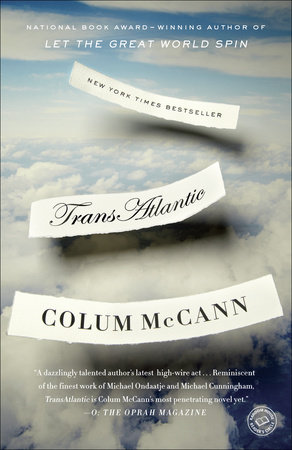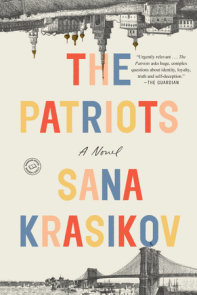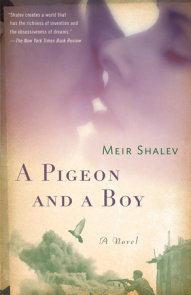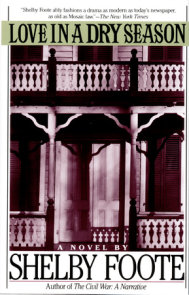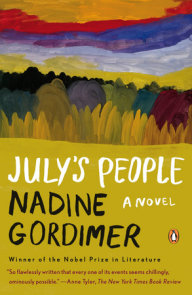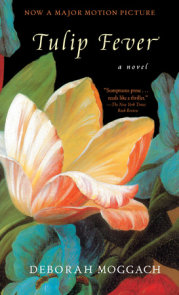READERS GUIDE
A Conversation with Colum McCann and Elizabeth StroutElizabeth Strout is the author of the New York Times bestsellers The Burgess Boys and Olive Kitteridge, for which she was awarded the Pulitzer Prize; the national bestseller Abide with Me; and Amy and Isabelle, winner of the Los Angeles Times Art Seidenbaum Award and the Chicago Tribune Heartland Prize. She has also been a finalist for the PEN/Faulkner Award and the Orange Prize in London. She lives in Maine and New York City.
Elizabeth Strout: I love the wide range of your narratives, how you dare to cover so many aspects of world events through the personal stories of those involved. How do you make the decision to end where you end, and begin where you begin? Is this an intuitive sense for you?
Colum McCann: Writing is very much about the intuitive, the gut instinct, the shotgun leap into the unknown. Most of the time, I don’t necessarily know where I’m going. I have a general goal, an end-line, but I’m not sure how it is that I’m going to get there. Being too conscious of a journey brings a malady to it. You can overthink it sometimes. It’s better to go with the gut feeling.
I think it’s very much akin to being an adventurer or an explorer. You know you want to find new territory. The nature of its newness makes it inherently exciting. You cast yourself out in a small boat in the hope that you will get somewhere. Most of the time you end up capsizing or catching the wrong current or, even worse, ship-wrecking. But every now and then—when the words are moving, and the sentences begin to align themselves, and the imaginative intent has caught fire with language—you strike new land. A sort of Galápagos of the imagination, I suppose. This is where the real exploration begins. You walk out and you meet new characters. And, in the best writing, you might create what amounts to a new theory.
And there’s something about the explorer in the reader too. You are casting into a new land, a new way of seeing. That’s how I feel when I read your work—when I got to explore Crosby in Olive Kitteridge, it was that sort of journey, it just opened me up. I love when that happens.
So for me it’s all about intuition. And beyond intuition lies what is hopefully a deep intelligence that we were looking for all along.
ES: You have a great understanding of how to use “real-life” events, and people, within the texture of the novel. What is your sense of fact versus fiction, and why do you think people tend to believe they are so different? I always get a kick out of people who say they don’t read fiction because it isn’t “true.” I’d love to know your thoughts on this.
CM: Ah, yes, what about all those embarrassing parties where you have to introduce yourself? You meet a couple and say, or rather admit, that you’re a writer of . . . stories. The woman’s face lights up and she says she loves to read fiction but her husband (always a little comfortably smug) looks beyond your shoulder and says he doesn’t read fiction at all, as if to put an end to the conversation—he only reads nonfiction because he is only interested in “fact.” It happens so often, I’m amazed by it. “Oh, yes, I don’t read fiction at all.” As if it’s a strange badge of honor.
But this line between fiction and nonfiction is a solid indicator of where we are right now, where so much of our national thinking occurs. If we watch Fox News, do we really think that we are witnesses to “fact”? If we allow our politicians to send our children off to war, do we really take on face value the “fact” that the offending nation has chemical weapons? What is fact? What is fiction? It’s one of our great political and social conundrums.
I suppose one of the reasons for writing TransAtlantic is that I wanted to question the gulf between what is “real” and what is “imagined.” Is there any difference at all? Can the imagined be considered real? And vice versa? Is Tom Joad not “real” because he was imagined by Steinbeck, for instance? Does this mean that the book we consider to be iconic in relation to our understanding of the Great Depression is actually irrelevant? To me, a much more interesting word than fiction is story, and then the word truth. Steinbeck allows us to know the Great Depression precisely because he fictionalized the truth. It is this way with so many of the great books. Why do I understand early-twentieth-century Ireland? Because I read Joyce’s Leopold Bloom. Why do I love turn-of-the-century New Orleans? Because I read about Buddy Bolden in Michael Ondaatje’s Coming Through Slaughter.
A story is a story whether it is based on real-life characters or not. A “real” person should be as fully fleshed as an “invented.” I have a duty to all my characters. And I want to braid the tapestry together so that “fiction” and “nonfiction” get confused.
Another question that fascinates me is the way in which we construct fictions around “historical” figures. Who owns history? Who has a right to tell it? What about the smaller, more anonymous moments? Aren’t they the glue of history? What about the little guy? Where is his or her voice? And when the little guys get together to shout, do they have a loud enough voice to topple the microphones of the ones who supposedly own history?
ES: Wonderful! Yes, real people should be as fully fleshed as invented people (and who isn’t invented, I ask you?). The women you invent feel as fully fleshed as anyone. It seems clear to me that you are just as invested in their stories as in any man’s. Is this a conscious decision? Or more of that gut working intuitively?
CM: I think we all know that women are so often excluded from the history books. As if guns and testosterone rule the world. In writing about the women, I felt like they were partly correcting a little corner of history. I wanted the women to own the novel. To say that their stories matter, not only to themselves but to history too. And, frankly, I like women. I like writing about them, I like imagining them, I like spending time with them as characters and as people.
There’s a symmetry in the book—three male “nonfiction” narratives, three female “fiction” narratives, and then a lone voice at the end, almost as if she has been narrating the whole novel. There’s a meaning behind this madness, I hope . . . it is, after all, a fairly anonymous woman, or rather a supposedly anonymous woman, who gets to have the last say. “We have to admire the world for not ending on us.”
ES: One of my favorite parts of this book involves Frederick Douglass going to Ireland. I think a lot of Americans may not realize he took this trip, and yet it is such an amazing tale. Was this something that you wanted to write about for a while, or did it arise out of the history of Ireland as you were rendering it?
CM: Douglass led me into the book. That was the original impetus. Not many Americans knew about his trip to Ireland and England, but not many Irish people even knew who Frederick Douglass was. He was largely omitted from the Irish history books, at least up until the 1990s (150 years after his journey), when scholars started to re-discover him when shaping up narratives that examined the history between the Irish and the Africans and the African Americans. Most people had relegated the story to the footnotes of history. But it was an incredible journey and a tremendous insight into the depth and character of Douglass.
Originally, after Let the Great World Spin, I wanted to write another sort of book altogether, a piece about contemporary surveillance cameras, believe it or not. But I just couldn’t catch that book, in fact I hated it, and I kept coming back to the idea of Douglass in Ireland. And the fact that his trip coincided with the beginning of the Famine. I was corralled. The only way I could shake it would be if I wrote about him. That’s how it is—we write towards our obsessions. And I was especially taken by this notion of a young black slave landing in Ireland and having enough experience to say, “Lo! the chattel becomes a man!” Then he looks around and knows that there are many forms of chatteldom. He struggles to become himself, as we all eventually do.
I hope my Douglass is texturally true. Facts can be misdirected and shoehorned in. Texture is a different story. It relates to an idea of general honesty. I wanted my Douglass to be authentic. I wanted him to emerge in all his complications.
ES: You do even more, though, which is to carry this up to the present day, and that’s so important, I think, to show the continuum we are all existing on.
CM: I suppose I wanted to write about Douglass because he could lead me up to examine some issues in contemporary Ireland . . . especially the peace process and the idea of the Celtic Tiger, our collapsing economy. The peace process in particular is crucial to our experience of the twentieth century. So I began with Douglass . . . and ended up with Senator George Mitchell. Two incredible statesmen who had made significant transatlantic journeys.
From there I began to try to weave all the stories together. The novel, therefore, I suppose, tries to become an alternative way of telling history. We cannot understand the present unless we dissect the past.
ES: How long do ideas tend to germinate in your mind before you find yourself setting them down on the page?
CM: I wish I knew! Douglass had been hanging around for a couple of years. Mitchell too. But you never really know what it is that fires them into the front of your brain. Perhaps it is desperation, or perhaps it’s inspiration. Most likely a combination of both.
ES: There is clearly an enormous amount of what one would call research that goes into this book. Did you write with one hand and read with the other? Or do these two parts of the process take place quite separately for you?
CM: I love research. That’s the part of the “job” that fires me up. I generally write towards something I want to know. I hope that I am learning all the time. Stepping out into new territory. But you can do too much research sometimes and it can begin to hinder the novel. So one has to be very careful. I always look for the “divine detail” in my research, that one thing that only an expert might know but the general public can recognize as being true.
For example, I give Douglass a pair of barbells when he is in Ireland. I know for a fact that he had barbells later in his life because they are on display in Washington, D.C., but I have no idea whether or not he brought them with him to Ireland. In fact, he probably didn’t. But it says so much about his character—his vanity, his stubborness, his awareness of his body in space, his forward thinking, his stamina. Furthermore, I have the barbells made from old slave chains. This is poetic license, but hopefully poetic enough that it rings true.
So the research blends in with the imaginative act until, really, they are one and the same.
ES: Of course, I am always interested in the concept of home, and the changing face of home. I wonder what you feel about this, having been born in Ireland and living in New York. Is writing about Ireland a form of love?
CM: I like this concept of trying to understand what is “home,” and I think you do it beautifully, whether that be the coast of Maine or the meadows of New Hampshire, and I love those writers who make me rethink my notions of home, whether they be a physical place or an imaginative space. I was born in Dublin, but—right up until TransAtlantic—I had only really mentioned Dublin in one short story and a small section of Let the Great World Spin. That’s twenty-five years of writing and I had more or less ignored the town where I spent my first twenty years. This baffles me, and I have no real answer for it. Of course, I do go back in TransAtlantic, but even then mostly as a visitor. I wish I could understand this better, but I’m forced to say that I’m stumped. I’m much more comfortable being “elsewhere.” Of course, New York is my home now, and I have a family here.
I like the notion that we can belong in many different places, what Ondaatje calls the “international mongrels” of the world.
ES: Tell us about the nonprofit organization Narrative 4 that you are involved with; it sounds fascinating to me. I’ve always thought of novels as powerful social tools that can teach through empathy what it is like to be another person.
CM: In 2012, a group of about twenty-five writers and activists got together and began developing a story exchange program where we wanted to develop notions of radical empathy. We wanted, as writers, to give something back. To be socially engaged. To push the parameters. And, quite frankly, to be relevant. We were all of the opinion that one of the big failures we have in the world these days is the failure of empathy. And so in 2013 we founded a group called Narrative 4.
What the group had in common was our love of storytelling, and we knew that storytelling legislates the world in so many ways. Stories are our vast democracy. We all have them. We all need them. They cross all boundaries. And so we wanted to concentrate, at first, on young people and have them step into each other’s shoes. The goal is to get young people together to tell one another’s stories. The kid from Belfast with the kid from Detroit. The teen from Nazareth with the teen from Haiti. For them to get together and share one another’s stories and walk in one another’s shoes. To have a responsibility for someone else’s life—if even for just a moment, which, if we do this correctly, will move through a lifetime and become part of a global narrative. The key to transformation lies in the sharing: when you hear someone else’s story deeply enough to inhabit it and retell it as if you’ve lived it, you become “the other” and see the world through his or her eyes.
I personally don’t think that literature or stories can necessarily change the world—but they can become a wall against the general despair.
ES: Narrative 4 sounds like an amazing organization, very exciting. I wonder if there is any one moment in your career that stands out when you felt you experienced your work as, as you say, a wall against despair.
CM: Oh, absolutely. Just last year I had a moment that floored me, humbled me, taught me—-I don’t really know how to describe it, except that it went to the heart of my ideas about literature. Shortly after the massacre at Sandy Hook, I got a letter from Lee Keylock, a high school teacher in Newtown. He said that he and a couple of other teachers had been searching for a book to help navigate the grief of the older students. They chose Let the Great World Spin. I was stunned. It seemed to validate so much of what I had been saying about literature for years: that we enter into these narratives to learn and to heal. We move beyond empathy to experience. In April 2013, I visited the school and sat with those kids. But I didn’t end up teaching them anything—they taught me. They were the ones who talked about morality, about finding light in the dark. And the fact that this teacher recognized that literature makes itself available for that is to me a stunning thing. It was one of the most defining moments of my literary career. It was a difficult experience but profoundly touching. Lee is now a significant part of Narrative 4. The story goes on. Once again, the world doesn’t end on us. . . .
Questions and Topics for Discussion
1. In this novel, Colum McCann writes about four men: Jack Alcock, Teddy Brown, Frederick Douglass, and Senator George Mitchell. Were you familiar with any or all of these figures before reading TransAtlantic? Did what you learn about them surprise you? Do you find their journeys thematically linked?
2. As Alcock and Brown fly across the Atlantic they have several close calls, including a moment when their plane spins out of control and a rough landing, all in the fierce cold and damp. Do you think anyone could, nowadays, make the same sort of journey they did? Why or why not? What sorts of physical challenges remain for adventurers and explorers?
3. Douglass forms relationships with several women in the novel: we see him write home to his wife, Anna, but he also indelibly shapes the maid Lily and becomes friends with Isabel Jennings. What do you think draws these very different people together? How do these small threads eventually create a tapestry?
4. Why do you think Lily follows Douglass to America? What does she hope to find there? Does this novel confront the impossibility of the American dream?
5. Book One is not chronological: after Alcock and Brown’s flight in 1919, we travel back to Douglass’s tour of Ireland in 1845, and then move forward once more to 1998 and Mitchell. How would your reading of the novel change if this section were differently arranged? What would happen to the novel if the sections concerning the women were woven directly into the stories of the men?
6. In the third section of the book, McCann takes us into the mind of Senator George Mitchell during the peace negotiations in Northern Ireland. What do you know about the Irish “Troubles”? How does Mitchell’s story enrich or change what you already knew?
7. The novel is structured so we meet the four men, seemingly unrelated, first—and then learn that women connected to all of them are multiple generations of one family. Why do you think McCann structures TransAtlantic in this way? What do the very male first half of the book and the very female second half tell us about men, women, and how we legislate history?
8. Lily loses most of the men she loves—the father of her first son, Tad; her sons, Tad, Adam, and Benjamin; and her husband, Jon. What do you think gives her the strength to continue on and become a successful merchant? Do you admire her? What does this say about the role of women in history?
9. In the course of TransAtlantic we see many technologies—to which we’re well accustomed today—at the moments they were still new, including airplanes, cameras, and automobiles. What does the novel tell us about these devices and how they bring people together (and tear people apart)?
10. There are two civil wars in the novel: the American Civil War, in which Lily loses her son, and the Troubles in Northern Ireland, which takes Lottie’s grandson, Hannah’s son. What does TransAtlantic show us about war? Who are its victims?
11. Why do you think Hannah leaves the letter behind with her hosts?
12. Some of the characters in the novel are based on real figures; others are entirely fictional. Is it easy to tell the two apart? How do these sets of characters illuminate one another? McCann has said in interviews that “the real is often imagined,” and “the imagined is often real.” What do you think he means by this?
13. The novel begins with an Eduardo Galeano quote that ends, “the time that was continues to tick inside the time that is.” Why do you think McCann chose to open TransAtlantic this way? How do you see the stories in the novel—“the time that was”—relating to today, “the time that is”?
14. As its title suggests, TransAtlantic is about Ireland and North America, and the ideas and people that cross between the two. What do you feel makes this international relationship special? What draws families and individuals back and forth between these countries?
15. What is the function of the Prologue of the novel, set in 2012? How does it frame the novel? How does it tie in with the last line of the book? What is McCann suggesting about the circularity of human experience?









